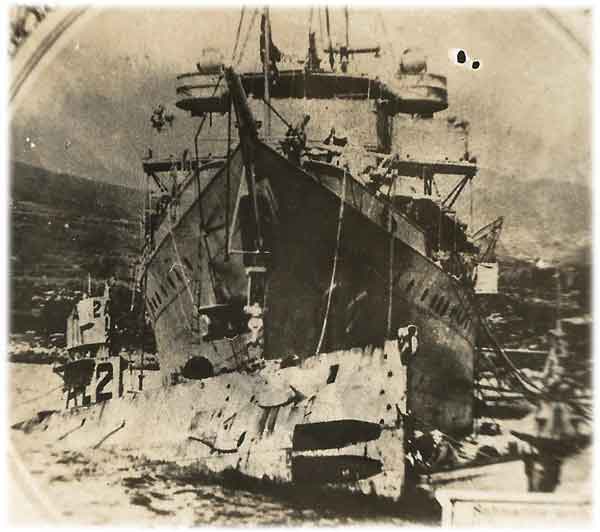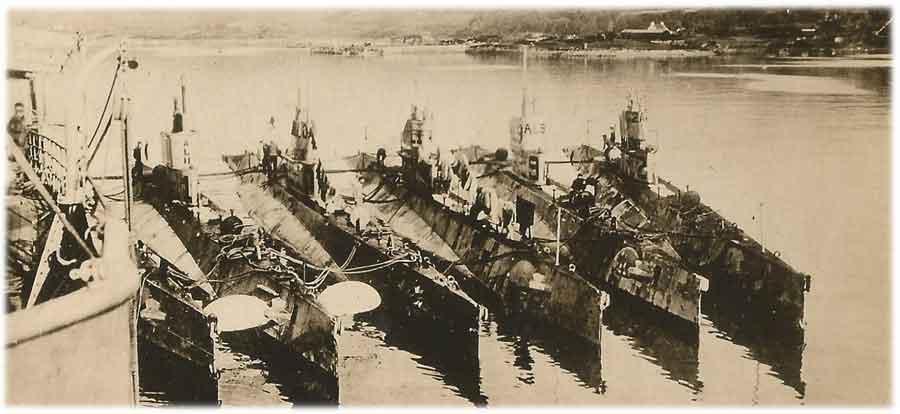

The United States entered World War One in April 1917. By May of that year the first US destroyers were patrolling the West coast of Ireland and the Irish Sea, alongside the Royal Navy, in an effort to combat the U-Boat menace. The German submarines were proving difficult to destroy, and in 1917, the British Navy had instituted a flotilla of ‘hunter-killer’ subs covering the North and West coast of Ireland. The United States Navy quickly investigated the tactics of the British submarines. In July 1917, Commander Boyd USN, sailed on patrol with the Royal Navy submarine D3 from Lough Swilly, to observe methods and tactics.

Admiral Benson sent a contingent of US submarines to Ireland in early 1918, to try to cover the South and Eastern parts of the Western Approaches. Seven L-Class submarines of Submarine Division 5 were towed and escorted to Ireland, via the Azores.Their escorts were the submarine tender USS Bushnell , and the tug Genesee . The weather on this journey was very poor, with the submarines and escorts battered by continual storms and high seas.

The first casualty among the submariners was that of Royal Allen Lees, Gunners Mate, 1st Class who was washed overboard from USS L-10 and drowned. Submarine Division 5 arrived in Cork, Ireland, between January and February 1918.
This force was under the command of Captain T.C.Hart USN, and in September 1918 Commander W.L. Friedell USN took over Captain Martin Nasmith VC, one of the most famous of WW1 Royal Navy submariners took charge of the training and operations of the submarines.
It became immediately apparent that there were serious shortcomings with the US boats. The L-Class submarine was only ever designed as a coastal boat. The diesel engines were unreliable and prone to breakdown, The optics of their periscopes were very poor compared to the Grubb-manufactured H.P.ones of the British, gradually all the subdiv5 periscopes were replaced with the British ones

The conning tower shelters were of little use in the stormy seas of the North Atlantic and required major fabrications to shelter the crew on watch.. The deck guns were of the disappearing-type, and had a terrible reputation for jamming either on deployment or concealment. These guns also had a habit of disappearing when recoiling, causing injury among gun crews. There were no cases of of these guns being used in action in WW1. Refitting of the submarines at Haulbowline, continued throughout their service in Ireland.
The identities of the US subs were changed from ‘L’ to ‘AL’ to avoid confusion with the British craft. Initially Submarine Division Five was to be based at Queenstown, but for the majority of the time, the force was based at Berehaven, in the South West of Ireland, and had as depot ship, USS Bushnell (AS-2) , as well as the tugs Sonoma and Genesee

Submarine Repair Ship/Tender USS Bushnell (AS-1)
The tactics of the US submarines were similar to those of the British subs. To cruise on pre-determined courses, usually at periscope depth, to try to catch unaware U-boats on the surface, then attack. The Royal Navy had more experience of these tactics, and helped to train the US submariners. Lieutenant Earl Childs, USN, was killed on board British submarine HMS H5 , when she was rammed by the merchant ship SS Rutherglen , in the Irish Sea. He was acting as an observer on this boat .
Active service began in March 1918, and for the submariners was to prove arduous and frustrating. Many contacts were made with suspected enemy submarines, but tactics and hunting technology were in their infancy and ‘kills’ proved elusive.
The only sure means of detecting another submarine was by sight. In order to track the enemy, directional hydrophones could only be used when the engines were stopped. A typical hunt would involve a few minutes under power, then minutes stopped listening for engine noises. The Fessenden Oscillator, a rudimentary underwater listening device was also used, but this did not give the bearing of the enemy.

The first American submarine to complete a war patrol was USS AL10 . She departed Berehaven on the 6th of March 1918, for patrol area QB ( Lat 51N, between 5 deg W and 6 deg W). There were constant problems with both periscopes during the patrol, and both had to be dismantled at one stage, leaving the boat vulnerable to attack.
USS AL4 made the first contact with the enemy while on route from Queenstown to Berehaven on March 20th. When about 6 miles east of Fastnet, a periscope was sighted 300 yards away. The commaning officer attempted to manoeuvre the boat into an attack postiton using hydrophone bearings but lost the enemy.
On the 19th of April USS Al3 came in conact with enemy submarine in postion 15.37N , 06.18W. Periscope was spotted and propeller sounds heard. The Commander tried to get to attack position, but lost sight of sub.
On April 30th, USS AL4 sighted enemy submarine at 05.00hrs, in position Lat 51.60N Long 07.30W. Fired two torpedoes and attempted to ram the enemy vessel. It appeared that the torpedoes passed under the submarine which then dived. Followed enemy using oscillator. At 07.20hrs enemy appeared on surface. Picked up on oscillator and newly repaired C tube, but lost her again.
On April 30th, USS AL4 sighted submarine awash, chased her but lost sight.
On April 31st USS Al4 sighted suspected submarine at 12.35am. Fired two torpedoes which missed. On getting closer it was discovered that the suspected submarine was actually a freighter.
On the 11th of May USS AL2 unsuccessfully attacked an enemy submarine pos 50.32N 05.39W
On the 11th of May USS AL2 unsuccessfully attacked an enemy submarine pos 50.32N 05.39W
On the 27th of July 1918 at 09/00hrs in pos 50.18N 07.45W USS AL2 sighted submarine on surface
On the 27th of July 1918 at 10.40hrs in pos 50.10N 08.20W USS AL1 sighted submarine on surface heading NW.
Submarine USS AL1 on 2nd Sep 1918 at 10.30hrs in pos 51.55N 11.56W Sighted enemy submarine on surface.
Submarine USS AL1 on 29th Sep 1918 at 18.15hrs in pos 50.40N 07.41W Sighted enemy submarine
Patrols continued throughout 1918, right up to the Armistice. There were no ‘kills’ recorded, but there were a number of contacts, and attacks made. One involved the USS AL-2 and a suspected U-boat , off Cape Clear, in South West Cork.
On the 10th of July, the Commander of the USS AL2 , Lieut Foster USN, had observed an enemy periscope on the surface, but before he had a chance to attack, a massive explosion occurred. It was thought that a torpedo had prematurely exploded in the other craft, destroying it. The identity of the mystery submarine has not been solved.
The patrol area was enormous, to the South and East of Ireland.This is on the edge of the Atlantic , with cold seas and frequent storms. These small submarines were pitched and tossed about by the waves much of the time. At the end of each one week patrol, the crews were exhausted.
On June 8th, 1918, Gunners Mate Horace. Elmer, Whitaker was lost overboard from the Berehaven-based boat USS AL-3 , and drowned. In October 1918 extended patrols were ordered off the south west coast of Ireland. This was needed in order to intercept German submarines returning from the Mediterranean. The heavy seas off this exposed Atlantic coast took their toll on boats and men, and no enemy were destroyed.
An important feature of patrols was to stay hidden from all shipping, as at that time, any submarine sighted was assumed to be a German one. Standing orders were to attack any submarine on sight. . This meant that there were plenty of attempted rammings and sinkings of US and British subs by friendly forces. It was best to stay out of sight.The German High Command were aware of the US submarine patrols, and they would have served to keep the U-boats under pressure, so their contribution to the war was never in doubt.
With the coming of peace, there was no need to keep this expeditionary submarine force in place. On Sunday 24th of November 1918, USS Bushnell and her seven L-Class submarines departed Cork Harbour. They were bound for Portland, England, and left in company with 30 US submarine chasers. Newspapers reported that they received a ‘great sendoff’ by crowds lining the shore.
US Submarine Division 5, (subdiv5) 1918
L-1 aka AL-1 (SS-40)
L-2 aka AL-2 (SS-41)
L-3 aka AL-3 (SS-42)
L-4 aka AL-4 (SS-43)
L-9 aka AL-9 (SS-49)
L-10 aka AL-10 (SS-50)
L-11 aka AL-11 (SS-51).
Many photographs of US Navy submarines in Ireland during WW1 can be found in the US Navy History Website http://www.history.navy.mil/index.html www.history.navy.mil/index
SOURCES
There have been a number of publications detailing the history of Queenstown (Cobh) during World War One. The standard reference works are those those listed below
Danger Zone. The story of the Queenstown Command.
By E.Keeble Chatterton
Little, Brown and Co, Boston 1934
(copy available in Cork City Library – local history section top floor)
The Victory at Sea. By Rear-Admiral William Sowden Sims, Doubleday, Page and Company, New York, 1921.
Simsadus London, The American Navy in Europe.
By John Langdon Leighton.
Henry Holt & Co, New York, 1921.
Available to download here
Annual Report of the Secretary of the Navy
For the Fiscal Year, 1918
Available to download here
Officers and Enlisted Men of the US Navy who died during WW1
Available to download here
Bayley’s Navy,
by Vice Admiral Walter.S.Delany (Rtd)
Available to download here
American Participation in the Great War,
by Captain Dudley W.Knox.
Available to download here
Naval Aviation in WW1,
by Adrian O. Van Wyen.
Available to download here
For Operational Records Various files from the Public Records Office,of the United Kingdom, Kew are invaluable, especially records of ADM137, which were files bound for the official history of WW1 Naval Operations. None of these records are digitised yet, and can only be accessed by visiting the British Public Records Office, Kew, near London.
www.nationalarchives.gov.uk/
For photographs of the Queenstown Command, the following websites have many photographs available to download free of charge. Most of the aforementioned publications also have photographic illustrations.
US Naval History and Heritage Command website
www.history.navy.mil
United States National Archives Website
www.archives.gov/
The British Imperial War Museum
www.iwm.org.uk/research
This site contains many photographs of US and British Naval operations in Ireland. Importantly, it also has a number of copies of unique newsreel footage. These can be played on the site.
